The importance of soil microbes for cannabis plants
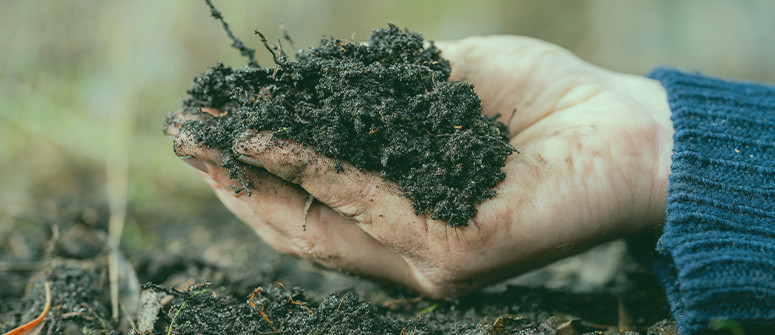
Many cannabis growers are so fixated on the status of their plants that they often overlook the very soil beneath their feet. Far from an inert brown substance, real living soil is home to billions of microbes. Some of these creatures are beneficial and optimise cannabis health and productivity. Discover how to harness them for better yields.
Contents:
To the naked eye, cannabis plants appear as stand-alone and isolated organisms. When you stroll around your garden or unzip your growing tent, you can clearly distinguish your cannabis plants from other beings and inanimate objects. Despite what your eyes tell you, every one of your plants is crawling with microscopic organisms that play a fundamental role in their health and development, from the roots to the buds.
Rather than stand-alone life forms, cannabis plants are a collection of organisms and genomes living in a symbiotic dynamic known as a holobiont. Much like our gut bacteria hold significant sway over our health and well-being, cannabis plants also possess their own microbiome that can either promote vitality or predispose them to disease.
The tiny critters that make up microbiomes, including bacteria, fungi, and other life forms, assist cannabis plants in almost every area of their physiology, including pest resistance and nutrient accumulation. Not long ago, agriculturalists thought that plants merely secured nutrients through cation exchange in the soil. This set the groundwork for dousing growing mediums with synthetic salt fertilisers, with little concern for the intricate workings of the rhizosphere (the slither of soil directly surrounding the root zone).
It turns out that soil hosts a huge range of microbes; conventional methods of agriculture harm these beneficial organisms, while so-called “living soil” practices help them to thrive. In turn, plants perform better, yield higher, and the soil becomes more fertile and alive with each growing cycle.
Continue reading to better understand the crucial role of microbes when growing weed. Below, you’ll learn about the major classes of organisms that keep the processes of the rhizosphere turning. Then, you’ll discover techniques to promote life within your soil to keep your plants healthy and your yields huge.
What are soil microbes?
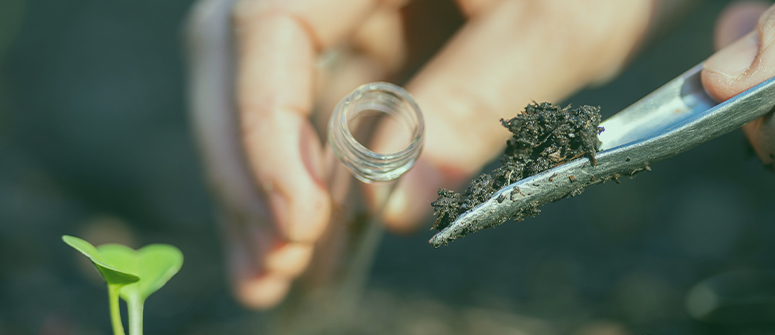
Soil microbes, also known as soil microorganisms, are microscopic creatures that live in the soil. Along with larger creatures such as arthropods and worms, they make up an important part of the soil food web—the interlinking series of food chains that fuel decomposition and nutrient cycling in the soil. To give you an idea of how abundant microbes are down in the root zone, around 1 billion individual microscopic cells, belonging to around 10,000 different species, are found in one teaspoon of soil.
Each class of microbes plays a unique role within this system, and each features its own means of reproduction. For example, many species of soil bacteria reproduce through binary fission—an asexual process that sees a single cell split into two. In contrast, soil fungi reproduce by releasing spores produced by both sexual meiotic and asexual mitotic processes, and many nematodes reproduce by fertilising themselves.
In essence, you can view the soil food web, and the microbes that comprise it, as one huge recycling centre. This huge system of life works to return what came from the soil back to the soil. After completing their life span, both animals and plants are stripped down and shredded, and their components are passed through a massive chain of organisms before they become humus (the end result of decomposition) once again. This process ensures that critical nutrients, such as nitrogen, are constantly cycled throughout the soil. This creates a closed-loop system that manages to keep gigantic old-growth forests thriving for thousands of years, without any input and management from humans.
Harnessing the concept of living soil means growers can apply this logic to their raised beds and containers. Instead of chucking on synthetic fertilisers, tilling excessively, and even throwing out used container soil, living soil techniques create a dynamic ecosystem of fertility that gets better and more complex with age.
Why soil microbes are important for cannabis plants
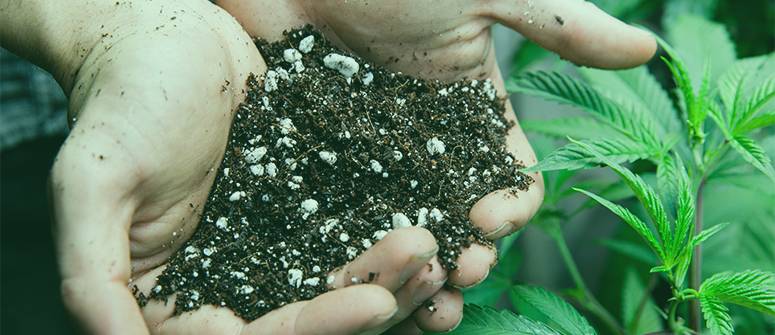
Humans have gained a staggering understanding of the natural world through scientific investigation. However, some things remain firmly outside of our intellectual grasp at this time, including the far reaches of space, the depths of the ocean, and the soil beneath our feet. Researchers are making huge gains in soil science, but the sheer number of microbes and their functions remains unknown.
With that said, we’re currently aware of many classes of soil microbes and their roles in the rhizosphere. Soil scientists know how they affect plant growth, and are also developing ways to culture and apply them within agricultural systems. Below, you’re going to discover the most important microbes that are good for cannabis plants. Then, we’ll delve into useful ways to encourage their growth and how to apply them to your soil and plants.
Bacteria
As some of the most abundant soil microbes, bacteria play a key role in the rhizosphere by breaking down organic matter and cycling nutrients. Many weed growers apply rhizobacteria to their plants as plant-growth-promoting agents that produce plant growth hormones and increase the bioavailability of key nutrients. Certain species of bacteria also serve as food that helps plants to stay nourished and healthy. Plants essentially farm bacteria by feeding them the sugar they create during photosynthesis. In the root zone, they uptake entire bacterial cells and extract their nitrogen during the rhizophagy cycle. Up in the canopy, plants also farm nitrogen-fixing bacteria in their trichome cells, and even protect them from oxidation using antioxidant cannabinoids and terpenes.
Actinomycetes
Actinomycetes are a type of Gram-positive bacteria that belong to the phylum Actinobacteria. They form long cellular strands that look cobweb-like in appearance. When it comes to decomposition, they do a lot of the heavy lifting by releasing potent enzymes capable of breaking down tough woody compounds such as lignin. Research shows great promise with these organisms when it comes to solubilising key nutrients and producing phytohormones. Actinomycetes also produce antibiotic compounds that can fight against pathogenic microbes.
Fungi
Although overlooked in the past, the newly named kingdom funga plays a critical role in the balance of ecosystems. Fungal species break down woody compounds, cycle nutrients in the soil, and even work side-by-side with plants to help them thrive. Mycorrhizal fungi are some of the most important organisms when it comes to growing cannabis. They fuse their strands of mycelium to roots to form a symbiotic relationship with plants; they mine and deliver key nutrients such as phosphorus and receive photosynthetic sugars, amino acids, and other compounds in return. These organisms can also help to neutralise diseases and guard against plant-parasitic nematodes.
Algae
Algae are usually associated with marine ecosystems, but they also exist in the soil, where they carry out important functions. As phototrophic organisms, they create energy by converting sunlight into carbohydrate compounds—much like plants. Algae also directly impact plant growth as biostimulants. Chlorella species of algae, for example, are known to ferry bacterial cells into plant roots, which serve as a source of nitrogen and help to spur root hair formation.
Protozoa
Protozoa are microscopic animals that also play a crucial role in nutrient cycling in healthy soils. Different types of protozoa feast upon a wide range of prey and food sources, including other protozoa, bacteria, and organic matter. There are three major groups of protozoa, each featuring a different form and therefore fulfilling a different function in the soil food web. These categories include:
- Ciliates: These types of protozoa are the biggest. They managed to move around the soil using the hair-like structure on their exterior. They feast on the other two groups of protozoa, as well as bacterial cells.
- Amoebae: This jelly-like type of protozoa are almost shape-shifters in nature. They morph parts of their gooey bodies into a “pseudopod” to move around and find prey.
- Flagellates: These are the smallest type of protozoa. They possess a whip-like tail that propels them through the soil.
Nematodes
Nematodes are microscopic worm-like creatures that typically measure 1mm in length. They work to transport microbes through the soil that ride on their bodies and also cycle nutrients by preying on a range of other organisms. Some are beneficial for plant growth, while others cause substantial damage to plant root systems. The main types of nematodes include:
- Bacterial-feeders: These nematodes work their way through the soil in search of bacteria. After feeding, they release excess nitrogen into the soil that plants can uptake and use.
- Fungal-feeders: These nematodes feast on fungal threads, known as hyphae, found in the rhizosphere and beyond. They possess specialised lance-like mouthparts to penetrate fungal cells and suck out the contents.
- Predatory: As their name suggests, these nematodes prey on other nematodes to get their nutrients. They are sometimes used as a biocontrol by cannabis growers to treat plant-parasitic nematode infestations.
- Plant-parasitic: These nematodes are bad news in a cannabis garden. They burrow into roots and feast on the tissue within. Large infestations can cause considerable damage, stunt growth, and reduce yields.
Which microbes are bad for cannabis plants?
Not all microbes are beneficial for cannabis plants. Many species of bacteria, fungi, and viruses can cause plant diseases. These infections can vary in severity, from minor reduction in yield and vigour, to quickly killing a plant entirely. Discover some of the most common culprits below:
- Powdery mildew (fungi): This disease occurs as a white powdery substance on cannabis fan leaves, stems, and buds. It’s caused by several species of fungi that grow as a superficial network on the plant surface. As well as feeding on the cells of the host plant, the thick layer of mildew can obstruct light exposure and reduce photosynthesis.
- Fusarium (fungi): This group of pathogenic fungi can cause serious damage to cannabis plants. They attack the roots and vascular system of plants—the internal apparatus responsible for transporting water and nutrients. Badly affected plants lose their ability to nourish themselves and begin to wilt and die. The key symptoms of this disease include wilting, yellowing, and browning of the leaves and stems.
- Hop latent viroid: As an infectious RNA molecule, this sneaky pathogen disrupts plant gene expression, preventing normal growth and development. The symptoms can vary from curling leaves and distorted buds to complete crop loss.
- Tobacco mosaic virus: This virus causes a mosaic pattern of light and dark green areas on leaf surfaces and also causes foliage to curl. It also disrupts chlorophyll function, which reduces photosynthesis and causes reduced plant vigour and productivity.
How to get beneficial microbes in your cannabis garden
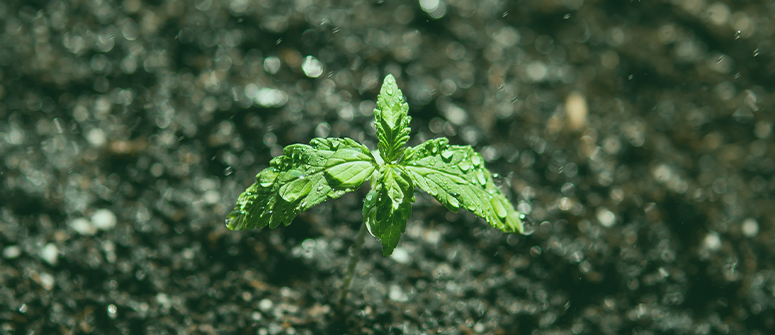
Thankfully, cannabis plants with a healthy and diverse microbiome are less likely to contract pathogens and pests. More life means more competition, which gives pathogens less room to gain a foothold. But how can cannabis growers enhance the biology in their soil to reap bigger yields and maintain crop health? Check out some of the most effective strategies below to fill your soil with beneficial microscopic critters.
Compost
Compost is essentially the lifeblood of any successful organic garden. This substance is the end result of decomposition and appears crumbly and dark brown when created properly. Compost offers growers a whole host of benefits; it improves soil structure, water-holding capacity, and drainage. On top of that, it works as both a probiotic and a prebiotic for your garden beds and containers. Because it contains so many microbes, it inoculates growing mediums. The organic matter and microbes in compost also feed the biology already present in the soil.
There are many different ways to create compost, from rapid hot composting to slower cold composting. Methods such as bokashi also use anaerobic decomposition and can break down inputs that can’t be placed into a conventional compost pile, including meat and fish.
Compost tea
Compost tea involves taking a handful of compost, rapidly multiplying the microbes within that sample, and applying them to plants. The process involves placing a mesh bag of compost into a bucket of water aerated with a pump. The addition of a nutrient source, such as molasses or fish emulsion, allows the microbes to multiply ferociously within the space of 24 hours. From here, growers dilute the tea and either apply it as a soil drench or as a foliar spray to combat diseases.
No-till gardening
Tilling harms soil biology. It shreds up worms, breaks up fungal networks, and tears apart stabilising soil aggregates. Conventional agriculture largely uses tilling to produce the crops we eat. Research shows that this practice, by impacting soil life, has led to a drastic decline in nutrient density. The same logic applies to cannabis. Destroying microbes through tilling leads to a weakened microbiome, reduced plant vigour, and increased susceptibility to disease.
Forgoing tilling not only preserves soil life, but it saves growers lots of physical labour. Instead of digging in compost at the start of every season, simply add a thin layer on top of your beds at the start of each season and let the biology do the rest.
Skipping pesticides
Pesticides have a detrimental effect on soil life in the garden, as well as the wider environment. Not only do they directly kill bacteria and other helpful microbes, but they also harm beneficial insects that also contribute to soil cycling and pest suppression. Consider using strategies such as polycultures, companion planting, and biocontrols such as Bacillus thuringiensis to prevent and manage pest infestations instead.
Avoiding synthetic fertilisers
Applications of synthetic fertilisers do wonders for luscious plant growth, but this short-term gain comes at a long-term cost. These ionic salts kill many beneficial microbes and even harm worms. They work well as a quick fix during signs of deficiency, but damage soil fertility over time. Avoid them, and instead build fertility with every growing season with applications of organic matter, compost, manure, and mulches.
Commercial products
As well as compost and compost tea, a range of commercial products are available that can quickly boost the microbial populations in your soil. These include mycorrhizal fungi powders, trichoderma, and nematodes. They help to add fuel to the fire while you're building the biology in your garden in the first year or two.
Why you should aim for living weed soil
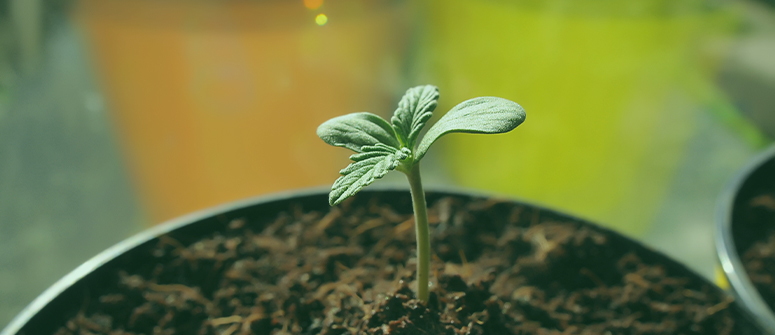
Ultimately, aiming to grow using living soil practices will create healthy plants that experience fewer pests, diseases, and deficiencies. You’ll also find yourself breaking free from dependency upon bottled fertilisers, pesticide products, and other unnecessary amendments. Simply building up the life in your soil by forgoing tilling, adding compost and mulch, and administering routine batches of compost tea, will allow you to increase the health and productivity of your cannabis garden year after year. The end result? A more streamlined growing process and better yields!
.jpg)


.jpg)
